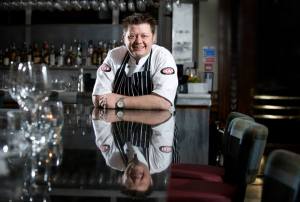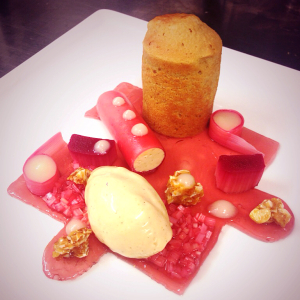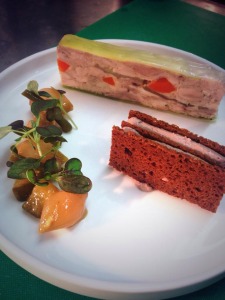 ][1]
][1]Mark Greenaway has worked as a chef for over twenty years. From Ayrshire to Australia and back, Mark has done stints in several notable restaurants picking up numerous AA Rosettes en route. He opened his first restaurant in Edinburgh in 2011 and was awarded three AA Rosettes within a year.
He currently has two Edinburgh restaurants under his name: Restaurant Mark Greenaway on North Castle Street and the more recent Bistro Moderne by Mark Greenaway in Stockbridge. The restaurants are run with his fiancée Nicola Jack.
Mark’s UK-wide profile was boosted sharply in April 2012 when he represented Scotland on BBC2’s Great British Menu. He competed again in the series in 2013.
In Edinburgh, Mark is perhaps best known in foodie circles for his innovative cooking and love of surprising the diner. This is perhaps most apparent at the Dining Club held on the last Wednesday of every month in the Bistro. Serving popcorn soup and helium balloons to diners are notable examples of his culinary playfulness.
Next Wednesday (30th April), the Dining Club is holding a four course dinner with the food themed around the 1920s.
Q: Can you describe your style of cooking?
MG: I’ve always called it progressive British or progressive Scottish. In Restaurant Mark Greenaway, I want diners to have a memorable night out. The prices are not necessarily special occasion (the market menu offers two courses for £17) but I want diners to have a special occasion. We use the best ingredients we can source and present them in a way which makes them special.
At Bistro Moderne by Mark Greenaway, we want the food to be instantly recognisable as bistro classics but given our own edge. In the bistro, we use the same ingredients as in Restaurant Mark Greenaway but there will probably be fewer of them and we will have used fewer processes or simpler techniques getting those ingredients to the plate.
 ][4]
][4]Q: You’ve appeared on the Great British Menu a few times. How did the Molecular Mark name come about?
MG: With TV, you need to have a handle or a short-cut so viewers know immediately who you are and what you do but I really wouldn’t call most of my dishes molecular. I do like to play around with the combination of time tested flavours and textures. It’s just that I might present them in a way that the diner might not expect.
Q: It’s a given that there is a Scottish culinary tradition of dishes such as Cullen skink, haggis and cock-a-leekie soup. Do you think it can be said that there is a modern Scottish cuisine?
MG: I’m Scottish and we use mainly Scottish ingredients, cooked in our restaurants in Edinburgh, Scotland’s capital. Does that make for a Scottish cuisine?
Some of our recipes might be loosely based on traditional Scottish dishes but modernised to a point where our great grannies might not recognise them. Or it could be that we present them very differently.
For example, at the moment, we are serving our version of a Scotch broth which is brought to the table in a glass coffee machine first invented by the Scottish engineer James Napier in the 19th century. The dish has strong Scottish roots and we present it in a way that updates that tradition while still remaining true to its roots.
Q: What got you into cooking?
I’d enjoyed cooking at home and thought I could do it when I left school. My first day didn’t work as planned. I’d seen a job advertised at the Cartland Bridge Hotel just outside Lanark. The job was for a kitchen porter and, although I didn’t know what a kitchen porter was, I figured that would be my way in. I was fifteen.
I turned up in my new chef’s whites with my toque and little kerchief and spent the day washing pots and doing the dishes. At the end of the day, I asked the head chef when I’d start cooking and he explained that that wasn’t what a kitchen porter did.
However, he did start me cooking the next day although for quite some time I still got thrown back on the pots if the new KP was ill.
Q: You can have anyone, live or dead, cook you a meal. Who is in the kitchen?
MG: Probably Gordon Ramsay. Just to see if he has still got it. It’s been a while since he spent any great length of time at the stove but I suspect that he could still rustle up something great.
Q: What aspect of the restaurant business would you most like to change?
MG: Now that I have my own business, VAT and rates would be the first thing I would change.
Q: What’s the best thing about being a chef?
MG: Experimenting with the food and seeing what we can come up with. Recently, we were developing dishes with Peruvian asparagus. We weren’t going to serve Peruvian asparagus in the restaurants but wanted to experiment with it so we were ready for Scottish asparagus coming into season.
 ][5]
][5]Q: And the worst?
MG: I’m going to have to say VAT and rates again. The hours are completely anti-social but I knew that from the beginning.
Q: What is in the fridge at home?
MG: Not much although there will always be root vegetables as we like to do a roast on day off. Nicola cooks that. We’ll also have lots of great cheese.
Q: What has been your strangest customer complaint:
MG: It’s not so much complaints as allergies. If someone says that their steak is not medium rare and I know that technically, it is, then I’m not going to get into that argument – we will cook another one.
It’s harder to get your head around people who say they are allergic to all green food or all red food. What is that about?
We had one customer who said they were allergic to dairy but could eat our ice cream because it was home made.
